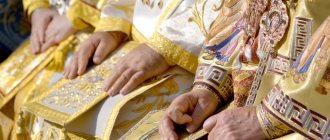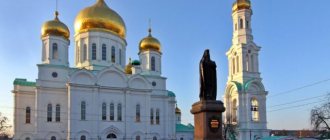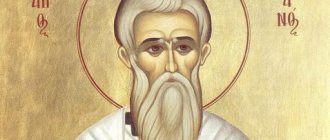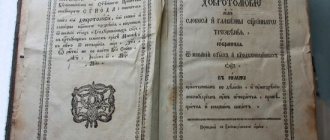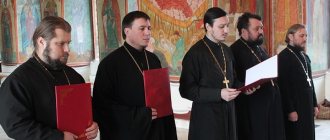Some words that were previously in use now lose their meaning or are used in a very narrow circle. This is what happened with the term “vicar”. "Who is this?" – many modern young people will ask. And those who study church history or medieval studies may recall phrases such as “vicar of Jesus Christ” in relation to the Popes. Let's try to figure out what this term is, how it appeared, and trace its history. Let's also try to understand who is called that now and why.
Vicar - definition of the word
Translated from Latin, this term means “deputy”, “representative”, someone acting “on behalf and on behalf of”. It is from this word that the prefix “vice” comes from. The term first appears as an administrative one back in the Roman Empire. Under Diocletian and Constantine, this was the name given to the rulers who had a diocese or region under their control.
Vicars were subordinate to the prefects and acted on their behalf. In the early Middle Ages in the Holy Roman Empire, this title was borne by local representatives of the supreme ruler. They administered justice and carried out administration on behalf of the emperor. This title was especially common in Italian cities. But this term became most famous in church administrative law after the victory of Christianity. Even in early times, bishops had their own vicars - assistants. They were archdeacons, as well as local parish priests who cared for human souls outside the dioceses.
The meaning of the word "vicar"
Vicar
- from the Latin word vicarius, which means deputy. This word is especially used in relation to officials. Since the time of Constantine the Great, the Roman Empire was divided into four large administrative districts - prefectures, which in turn were divided into dioceses. At the head of each prefecture was a praefectus praetorio, and at the head of each diocese was a ruler, subordinate to the prefect and called vicarius (praefectorum). V. was appointed directly by the emperor and, within the limits of his diocese, enjoyed the powers of a prefect in supervising the rulers of the provinces (a division of the diocese), however, without the right to remove them from office. But when the prefect himself was present in the diocese, the vicar lost all power. This characteristic feature makes V. a person, as it were, authorized by the prefect, who at any time can destroy these powers. The vicariate position retained the same character in the church, where this term became widespread. In the Roman Catholic Church, first of all, the Pope himself, as the successor of the prince of the apostles Peter, whom Christ appointed as his deputy, is called vicarius Jesu Christi. In turn, the Pope appoints deputies for himself, who are called apostolic V. (vicarii apostolici), also born legates (legati nati), if this title is associated not with the personality of the bishop, but with a certain see, central for a given district, as a result of which every bishop who enters this see, eo ipso becomes a papal vicar. Such wars appeared in the 5th century due to the difficulty of relations between remote provinces and Rome. Within more or less extensive territories, they were granted the exercise, on behalf of the Pope, of certain higher government rights to convene councils, to consider controversial cases between bishops, to accept appeals, etc. The papal archbishops were: Thessalonica - for Illyricum, Arelates - for Gaul, Seville - for Spain. To the VIII table. permanent papal v. disappeared and reappeared in the 11th century, when this title with more or less extensive powers was granted to the archbishops of Salzburg, Mainz, Trier, and Hamburg-Bremen. At present, the appointment of apostolic V. takes place only as an exception, under extraordinary circumstances; Only in Austria is the head of the military clergy considered a papal priesthood (vicarius castrensis), and thanks to the successes of Catholic missionaries, apostolic priesthoods appeared in Australia, China, the Pacific Islands, etc. Roman Catholic diocesan bishops also have vicar bishops (vicarius in pontificalibus), who are otherwise called titular bishops (episcopi titulares), since they have only a title without corresponding episcopal jurisdiction, and also bishops in partibus (infidelium), since they are consecrated to fictitious chairs located in the countries of the infidels. The fact is that the First Ecumenical Council established the principle that there should not be two bishops in one diocese. Meanwhile, bishops of vast dioceses from ancient times needed assistants to the episcopal rank, who would carry out the functions of their episcopal priesthood for them. When in the 13th century the pagans of Livonia and Prussia expelled many bishops from the newly established dioceses, and at the same time in the East with the fall of the Latin Empire there were a significant number of bishops who lost their see, the bishops of vast European dioceses took advantage of the services of these expelled bishops. This order of things became permanent, since the Pope, in order to protect his rights to the once existing dioceses of the Catholic Church, gave and still gives successors to the dying bishops of these fictitious dioceses. Thus, in the Roman Catholic Church, the suffragan bishop is an assistant to the diocesan in the exercise of his rights of episcopal priesthood (ju ra ordinis); he is appointed by the Pope on the proposal of the diocesan bishop. The vicar general (vicarius generalis) has a different meaning This is an assistant to the diocesan bishop in managing the diocese and in exercising his governmental rights (jura jurisdictionis). The bishop has the right and obligation to personally govern his diocese, therefore he can do without the general V.; The Pope can force him to decree the latter only if the bishop is insufficiently familiar with canon law or in the case of the vastness of the diocese. The Vicar General must have a doctorate or licentiate degree in canon law or theology and be versed in jurisprudence, but he is not required to have any degree of holy orders; it is enough that he generally belongs to the clergy, that is, has a tonsure. Between the authorizing bishop and the general V., who accepts the authority, unity of person is assumed, so that both of them are legally considered as one authority, and appeals against the actions of the general V. are sent not to the bishop, but to the next instance - to the archbishop. By virtue of the same unity of persons in the presence of a bishop, that is, when the bishop himself personally performs any government act, the general V. legally does not exist. His rights cease immediately with the termination of the rights of the bishop himself; in addition, the bishop can take back the powers given to him at any time. Sometimes specialization of administrative and judicial matters is allowed, so that the General V. is entrusted with only administrative matters, while for judicial matters there is another assistant, under the name of an official. The legal position of both is the same. In German dioceses, under the General V. there is usually an entire collegial institution, and where there has been a specialization of administrative and judicial affairs with the assignment of both to various officials - the General V. and the official - there are even two collegial institutions: the General Vicariate and the Officialate or Consistory . Sede vacante, i.e. when the episcopal see is vacant, or sede im pedita, i.e. when the see is not legally considered vacant, but in fact the bishop is rendered unable to exercise his episcopal office (for example, due to imprisonment, capture, but not due to illness, when a coadjutor is appointed), the management of the diocese passes to the cathedral chapter, which within 8 days must appoint an steward to manage the property of the bishopric and a capitular vicar (vicarius capitularis) to exercise episcopal jurisdiction. Within Russia. the empire, under the Roman Catholic diocesan bishops, consists of suffragan bishops (suffragans), who are appointed by the emperor after preliminary communication with the Roman Curia; on behalf of the diocesan bishop, they can correct the functions of the general V. In the event of a vacancy in the department, the cathedral chapter elects a vicar until the department is replaced. The Western Catholic principle of vicarious jurisdiction is expressed in Russia in the fact that the positions of members of the Roman Catholic. consistories cease with the death of the bishop or in the event of his resignation from the episcopal rank, as well as with the termination of the administration of the vacant see by the vicar. Finally, in the Roman Catholic Church, parish priests (parochs) can have V. They are permanent (vicarii perpetui), when the parish has branch churches, chapels, or when the parish is distinguished by its large population, and temporary (v. temporarii), appointed in in the event of a steamer's inability to hold a position, as well as for the period of vacancy of this position. The latter kind of V. are also known in the Protestant Church. Wed. Deneubourg, “Etude canonique sur les vicaires paroissiaux” (Par., 1871).
In the ancient Russian church, the bishops had a viceroy, who was his main representative in the field of court and administration. Initially, this was a clergy person, but at the end of the 14th century, when a special service class was formed under the bishops in the person of episcopal boyars and boyar children, a secular person could also be the governor. The existence of the bishop's boyars came to an end at the beginning of the 18th century. The institution of suffragan bishops has only recently received widespread development. In pre-Petrine Rus', under the Metropolitan of Moscow alone and later under the Patriarch of Moscow, there was an assistant with the rank of bishop, the Bishop of Sarsk and Podonsk, under the patriarchs renamed Metropolitan of Krutitsky, who, after the fall of the Sarai Horde, began to live in Moscow on Krutitsy, without ceasing, however, to be a bishop his former diocese. At the council of 1667, it was intended that all four metropolitans appoint auxiliary bishops who would live in the monasteries designated by them. This assumption did not come true, just as the desires of the Supreme Privy Council to transfer the management of the dioceses of the members of the Holy Synod into the hands of specially appointed vicars were not realized subsequently. In 1698, Peter the Great allowed the Kyiv bishop Varlaam Yasinsky, “due to the weakness of his health,” to elect and consecrate himself a bishop-coadjutor, so that this privilege would extend to his successors. By the end of the 18th century. there were suffragan bishops in the dioceses of Novgorod, Moscow and Kyiv. In the present century, cases of defining vicars as bishops auxiliary to diocesan bishops have become more frequent, and in 1865 it was given the highest permission to establish vicariates in all dioceses, where local sources of their maintenance can be indicated without burdening the state treasury, namely fairly wealthy monasteries. A vicar bishop is consecrated bishop of one of the cities of a given diocese; but this does not mean that a bishop who receives his title from one or another city has this city and the district belonging to it in his church administration. The vicar is only an assistant to the diocesan bishop, primarily in the exercise of sacred rights; his participation in diocesan administration is not determined by any fixed rules. Usually, at the discretion of the diocesan bishop, he is entrusted with a preliminary review, and sometimes approval of consistory journals and protocols; further, he is transferred to matters regarding the accession of non-believers to the Orthodox Church, the issuance of peace, consecrated antimensions, metric certificates, passports to clergy, the submission of church repentance according to reports from public places, etc. If there is a vacancy in the episcopal see in a diocese in which there is a ., decrees from the Holy Synod are addressed to Bishop V. Due to exceptional local circumstances, some suffragan bishops with their subordinate ecclesiastical boards actually conduct church government in a prominent local area. These are the vicar of the Kholm-Warsaw diocese - the Bishop of Lublin, who carries out administration and spiritual court within the former Greek-Uniate Kholm diocese, and the vicar of the Irkutsk diocese - the Bishop of Chita, who is in charge of diocesan affairs of the Transbaikal region. In a completely exceptional position is the vicar of the Riga diocese, the Bishop of Revel, who is not subordinate to his diocesan bishop and serves as an episcopal bishop in Japan, where he resides. Currently, there are 4 vicars under the Metropolitan of Novgorod, St. Petersburg and Finland - one for the diocese of Novgorod and 3 for the diocese of St. Petersburg; under the Metropolitans of Moscow and Kiev - 3 vicars each; in 5 dioceses (Vyatka, Georgian, Irkutsk, Lithuania and Kherson) there are 2 vicars each and in 21 dioceses there is one vicar. On the position of suffragan bishops from the point of view of canonical cf. N. Suvorova, “Course of Church Law” (Yarosl., 1890, part II).
Catholicism
Popes often used the title "Vicar of Christ". That is, they considered themselves God's representatives on earth. The meaning of the word "curate" in this sense is first used since the eighth century. Until then, Popes had limited themselves to calling themselves Vicars of St. Peter. They were also called differently - “vicars of the head of the apostles.” But in addition to such a solemn meaning in canon law, this term also has a purely administrative meaning. Representatives of any church institution were called vicars. They also had various other names, depending on the role played.
Types of vicars in Catholicism
In this church, canon law provides for many types of such substitutes. For example, an apostolic vicar is a bishop or priest who heads a special mission of the church and represents the Pope in territories where there are no dioceses. This is what legates were often called. There were also deputy bishops who had legislative and executive power in the lands entrusted to them. These are vicars general and judicial vicars. However, they did not have the right to inherit the department. Bishops were also called vicars. They were delegated certain powers of bishops within the diocese. And the lowest type of vicar is the assistant to the parish priest.
The bishop from Nizhny Tagil became the patriarch's vicar. What is he famous for?
The bishop is 47 years old. Father Evgeniy accepted the priesthood in 2004. Prior to this, Alexey Kulberg graduated from a university with a degree in systems engineering and in 1995 founded his own computer company. In those years, he was a member of the militant ultra-right organization “Black Hundred,” writes the portal “Forbidden Art,” referring to Kulberg’s associates.
Also, before Father Evgeniy received the priesthood, in 2003, he and his fellow believers staged a pogrom in one of the exhibition halls of the center-museum named after. Andrei Sakharov in Moscow, where the exhibition “Beware of Religion!” was held. There were exhibits such as an icon with a slot for the head and the sign “Photo. Cheap”, an image of a naked woman on a cross, icons with inscriptions in the faces of “Lenin”, “Revolution”, etc. Kulberg and his like-minded people poured paint on the paintings and broke the glass. They were detained and then released on their own recognizance.
Later, commenting on these events, the priest said that the organizers of the exhibition themselves provoked the attack. According to him, the pogrom carried out is a civil position, even if it is outside the legal framework. Kulberg said that such events must be coordinated with special public councils, which will include representatives of the Russian Orthodox Church.
In 2005, Alexey Kulberg became rector of the Church of the Nativity of the Virgin Mary in the village of Velikoye, Yaroslavl region. There he introduced a course in high schools about the basics of Orthodox life and opposed the use of condoms in sex. “When married worldly people decide to use contraceptives, their motive is clear - they want to free themselves from the responsibility associated with entering into an intimate relationship, that is, conceiving a child,” he said, adding that a person should not resist “divine will for the sake of pleasure."
In 2011 he arrived in the Urals. At first, Kulberg was the rector of the Great Chrysostom Church, and since 2014, the rector of the Ascension Church and the head of the diocesan press service. In 2016, he became the Bishop of Sredneuralsk and acting rector of the monastery complex on Ganina Yama. Kulberg adopted the name “Evgeniy” in July 2016 - in honor of Dr. Evgeniy Botkin, who died in the Ipatiev house along with the family of the former Emperor Nikolai Romanov.
In 2022, Father Eugene was engaged in the fight with the film “Matilda”, which tells about the romantic relationship of Nicholas II with a ballerina. Then, together with the Yekaterinburg diocese, he launched a portal about the royal family in order to give people a biography “without any judgment of his own, without distortion, without evaluation.” “Matilda” is just one “snot” in an organism affected by the virus of untruth or lack of information. After all, all this didn’t start right now—the distortion of the image of the Russian sovereign,” the priest said in an interview with 66.RU.
In 2022, the priest headed the Nizhny Tagil diocese. Having become a bishop in Nizhny Tagil, he stated that the main enemy of modern society is lies on the Internet and on television. According to him, she bears “the wounds of the vices that are promoted by modern society.” “This is a victory that we have not yet won. And we need to work hard to achieve it,” said Father Evgeniy.
Previously, it was he who advocated that Yekaterinburg blogger Ruslan Sokolovsky, who caught Pokemon in the temple, be given a real sentence.
Father Eugene is considered a person close to Metropolitan Kirill. He influenced the policy of the Yekaterinburg Metropolitanate.
|
Now, having become the vicar of Patriarch Kirill, Father Eugene will not have his own diocese and will help in administration. In other words, the priest was appointed as the patriarch's deputy.
In July of this year, Father Eugene, together with the Patriarch of Moscow and All Rus', celebrated the Divine Liturgy at the Cathedral of Christ the Savior in Moscow. During the ceremony, they prayed to stop the spread of coronavirus. After this, there were rumors that Evgeny (Kulberg) would move to Moscow.
Orthodoxy
This title is also used in the Eastern churches. In Orthodoxy, a vicar is an auxiliary bishop. It does not have its own diocese. Orthodox vicars can also bear different titles. For example, if such a bishop helps to govern a certain part of a diocese, then it is called a vicariate, and his powers extend only to this limited territory.
There may also be a city under the control of the vicar, where services are carried out under his leadership. Typically large dioceses have one or more deputy bishops to whom some authority is delegated. However, unlike Catholicism, such a vicar does not have independent jurisdiction. In some Orthodox churches, such stewards are called chorebishops. In Russia, this term appeared under Peter the Great and was finally strengthened under Catherine the Great.
At the end of the 19th and beginning of the 20th centuries, issues related to changes in church governance began to be discussed more and more often in the Russian Orthodox Church, both at the highest level and at the diocesan level. One of the main problems that was recognized in the Church even before the reign of Peter I began was the large size of dioceses. The ruling bishop was physically unable to regularly visit the monasteries and parishes entrusted to him, and this, in turn, made the successor of the Apostles in the eyes of his flock an official of the Department of the Orthodox Faith. They tried to solve this problem in several ways, first of all, by dividing large dioceses into smaller ones. Another option for solving the difficulties that arose was the spread of the institution of suffragan bishops, assistants to the ruling bishop. But despite the wide spread of the institution of suffragan episcopate before the revolution of 1917, there was no clearly defined law regulating their activities, rights and responsibilities.
If we turn to the history of the Orthodox Church of the first centuries, we will see that there was an institution of chorebishops, who, to a certain extent, were the predecessors of suffragan bishops. But this institution began to disappear already from the middle of the fourth century, followed by decisions of a number of Councils that prohibited the installation of chorebishops in small towns and villages. Thus, the Council of Laodicea 57 prohibited the installation of chorebishops: “It is not proper to install bishops in small towns and villages, but perideuts: and those who have already been appointed before should not do anything without the will of the bishop of the city.”[1].
Ancient Rus' did not know suffragan bishops in our understanding of the word. But it would be incorrect to say that the institution of vicar episcopate is the result of Petrine reforms in our church life. From the history of the Russian Church already in the first centuries it is known that the metropolitans of Kyiv often appointed their vicar, a priest or even a layman, to the large cities of their metropolis[2]. Metropolitan Theognostus of Kiev (1328–1353), being in old age, ordained his closest assistant Alexy to the rank of bishop. The future metropolitan lived in Moscow and helped him in the affairs of governing the metropolis. From the history of the First Patriarchal period (1589–1700) it is known that first the metropolitans of Moscow, and then their Holiness the Patriarchs, had as their assistant in the administration of the Moscow diocese the bishops of Sarsk and Podonsk, whose residence was located in Krutitsy. In 1589, the Patriarchate was established in Russia, and in the same year the Krutitsa Metropolis was established. The Krutitsa metropolitans become the Patriarch's closest assistants in matters of government, becoming Patriarchal vicars in the Moscow diocese. They retain this title to this day.
The main document regulating the entire life of the Russian Orthodox Church and determining its status during the Synodal period was the “Spiritual Regulations”, compiled by Archbishop Feofan (Prokopovich) and personally edited by Emperor Peter I. The document consists of three parts. The second part is important for the topic under consideration, since it describes the terms of reference of the Holy Synod and the diocesan episcopate. Concerning diocesan administration and considering cases when a bishop for some reason cannot fulfill his duties, the “Spiritual Regulations” are completely silent about vicar bishops: “If the necessary need arises, keeping him outside the Diocese, it is the turn, for example, to serve in the Reign city, ... in such a case, the Bishop, in addition to his ordinary house stewards, must assign to the affairs of a certain intelligent and honest man, an Archimandrite or Hegumen, assigning to help him several other intelligent people from the monastic or priestly rank; and they would inform him of important matters in writing to the absent Bishop, and they would inform him in words in words, if he can listen due to his weakness. And if things happened that their administrators were perplexed to decide, they would write about it to the Spiritual Collegium, as was said above about the Bishops themselves.”[3].
It is officially believed that the first vicar in the proper sense of the word was given to the Kyiv Metropolitan in 1700, but this is somewhat incorrect[4]. After all, even earlier, the first vicar see, with the title Korelskaya, was established on January 18, 1685 as a vicariate of the Novgorod metropolis. One of the main tasks of this vicar bishop was to establish church life in Karelia. The first vicar was Bishop Leonty, who had previously been in Tambov, but was exiled to the north for some guilt[5]. The vicariate lasted until 1690. After Bishop Leonty moved to one of the Suzdal monasteries, the Korelsky Vicariate did not have a bishop for 18 years. Only in 1708, Bishop Joel (Vyazmitin) was appointed here, with the title of Karelian and Ladoga, vicar of the Novgorod Metropolitan.
At the end of the seventeenth century, Metropolitan Varlaam (Yasinsky) of Kiev turned to Peter I and Patriarch Adrian (1690–1700), who asked them for permission to have an assistant in the episcopal rank due to his advanced age. The Metropolitan received permission and on October 1, 1700 ordained Zacharias (Kornilovich) Bishop of Pereyaslavl. At that time he did not bear the title of vicar, but was called “coadjutor.” But this term did not take root in church life; assistants to the ruling bishops in the rank of bishop began to be called vicars. It was understood that the right to have an assistant in the episcopal rank would pass to subsequent Kyiv metropolitans.
But the practice of having an assistant in the rank of bishop began to spread to other dioceses of the Russian Church. One of the reasons for the establishment of the institution of vicariates was the enormous size of the dioceses and the constantly growing number of parishes. Even then, the diocesan bishop actually did not have the opportunity to exercise full control over diocesan life for the above reasons, as well as because of the difficulties of moving around the territory of the diocese. The question of caring for the flock in the vastness of Siberia was especially acute. On December 15, 1707, Metropolitan of Tobolsk was given a vicar with the title of Irkutsk and Nerchensk. This vicarage existed until September 8, 1720, when the independent Irkutsk diocese was founded[6].
Peter I's disagreement with electing a new Patriarch leads to the fact that the Moscow diocese is forced to be governed by the Patriarchal Locum Tenens, Metropolitan Stefan (Yavorsky) of Ryazan. He had absolutely no opportunity to manage not only the Ryazan department, but even the Moscow one, since he had to live for a long time in the new capital. The long absence of the ruling bishop led to the fact that diocesan affairs were simply not resolved. In 1718, Peter's decree followed that Metropolitan Stefan should appoint a vicar to the Ryazan diocese, with the same rights and responsibilities as the vicar of the Novgorod metropolis[7].
The church policy of Peter I regarding the institution of suffragan bishops was not consistent. Giving instructions to Metropolitan Stefan (Yavorsky) about the appointment of a vicar in Ryazan, he later issued a decree that bishops were forbidden to install vicars and governors in monasteries, and instead they should appoint clerks[8]. This decree did not directly prohibit suffragan bishops, but strictly limited the ability to appoint vicars as vicars of monasteries[9].
Empress Catherine I, regarding issues of church administration, issued a decree on July 15, 1726 that diocesan bishops who were summoned to meetings of the Holy Governing Synod should not at all touch upon issues of management of their dioceses. The dioceses of synodal bishops must be governed by suffragan bishops, vested with full episcopal power[10].
Under Catherine the Great, the process of installing suffragan bishops in various dioceses continues. The decree on the secularization of church lands contains instructions regarding the activities of suffragan bishops. A suffragan bishop with a see in Olonets remains in the Novgorod Metropolis. The Metropolitan of Moscow is also appointed a vicar with a see in Sevsk. The main reason for the appointment of vicars to these dioceses is the huge territory. These suffragan bishops must independently govern those parts of the dioceses that the ruling metropolitan will allocate to them. They must have a special staff and house with them[11]. They were entitled to an annual salary of 4,030 rubles.
When studying the issue of the development of the institution of suffragan bishops, a number of points are clearly visible that guided the authorities when appointing assistants to the ruling bishops, one of which was the huge size of the dioceses. Under Catherine II, another nuance was added - religious and political. On March 27, 1785, the Empress issued a decree appointing a special vicar or coadjutor to the Kyiv Metropolitan with the title of Pereyaslavl and Borispol[12]. The main task of all the activities of this vicar bishop was the care and preservation of Orthodoxy in Poland; he was entrusted with the responsibility of protecting the Orthodox in a Catholic country. A political motive was also present in the appointment of a vicar to the Ekaterinoslav diocese. A vicar bishop with the title of Feodosiya and Mariupol was appointed to care for the Orthodox Greeks, who began to actively move into the Empire during these years[13].
An important basis for the activity of the suffragan bishop is the decree of Empress Catherine of March 15, 1787 on the appointment of another vicar to the Novgorod Metropolis with the title of Starorussky. He was forbidden to have his own cathedral, consistory. Must manage the affairs of the diocese under the command of his ruling bishop[14]. This decree more clearly described the external position of the suffragan bishop, but said absolutely nothing about his rights and responsibilities in governing the diocese. Vague wording about the range of issues that can be entrusted to him by the highest diocesan authority. Later, under Catherine, several more vicars would be ordained, but nothing special was observed in their appointment. The authorities in these cases are guided by previously issued decrees regarding the life of suffragan bishops.
One of the key church figures during the reign of Catherine II was Metropolitan Platon (Levshin) of Moscow. His closest assistant in the management of the Moscow diocese was Augustine (Vinogradsky), Bishop of Dmitrov, vicar of the metropolis, installed back in 1788. The role of Bishop Augustine in resolving diocesan affairs was constantly increasing. This was due to the fact that Metropolitan Platon spent a lot of time in St. Petersburg at the Holy Synod, and a little later the health of the ruling bishop of Moscow began to deteriorate. Since 1796, Bishop Augustine has led the Moscow diocese, and in fact he has become the ruling bishop since June 1811, when Metropolitan Platon, for health reasons, almost completely retired from diocesan affairs. But at the same time, he gives instructions to his vicar in the management of the diocese:
1. when managing my flock, let me know briefly about the decrees of the Synod;
2. monastic affairs for all requests to be related to me;
3. if something special happens in any place, first write to me and ask;
4. If you decide to report something else to me, then in this case you are allowed to write to me[15].
Thus, Bishop Augustine independently resolved almost all diocesan issues, with minor exceptions. With all this, he maintained a filial attitude towards Metropolitan Plato. He said that on every issue he asked for the bishop’s blessing, although he could decide on his own[16].
An important stage in the development of the institution of vicariate was the reign of Emperor Nicholas I. Under him, more than 10 new vicariates were established, and a number of suffragan bishops had their own characteristics. On December 25, 1833, a vicar of the Perm diocese was appointed with the title of Yekaterinburg[17]. The Bishop of Yekaterinburg had a cathedral, a bishop's house, a special staff and ministers, and a salary of 4,000 rubles. The vicar of the Vologda diocese of Veliko-Ustyug had independent spiritual rule in his district city. The Bishop of Sarapul, vicar of the Vyatka diocese, also had similar rights. A similar situation developed on the western outskirts of the Empire, in the regions of the former Kingdom of Poland. But here there was another reason for this - the majority of the population of the Vistula region were Catholics, and the Orthodox were a minority. The vicar of the Warsaw diocese, Bishop Kholmsky, ruled the vicariate virtually with the rights of a diocesan bishop. In fact, in the Russian Church there were several dioceses in which there were 2 independent bishops.
In fact, this meant that in one diocese there were two independent bishops. The large size of the diocese did not leave the opportunity for the ruling bishop to actively intervene in the affairs of his vicar, who, thus, received greater freedom in deciding diocesan affairs than other vicars. Several other conclusions can be drawn from this decree. By this time, the tradition had already clearly developed that the vicar lived in the monastery, and not at the cathedral. His residence is located near the diocesan center or in it. In the diocese, suffragan bishops had power, but it was insignificant. The vicar bishop could appoint psalmists to the parish. The range of issues that the vicar could resolve was outlined by the ruling bishop. There were no synodal decrees regarding the rights and duties of suffragan bishops.
In 1865, Emperor Alexander II, by his decree, allowed diocesan bishops to have vicars, but with one caveat - the diocese itself must support a suffragan bishop, without burdening the treasury of the Empire. By the beginning of the twentieth century, there were suffragan bishops in most of the dioceses of our Church. They were usually titled after one of the cities of the diocese. They did not actually live in their cities, with rare exceptions.
There were separate imperial decrees that regulated certain aspects of the life and church service of suffragan bishops. Thus, if a vicar bishop wanted to take a vacation of no more than 29 calendar days, he had to obtain the consent of his diocesan bishop. If the period of leave exceeded the specified period, then he had to write a petition to the Holy Synod[18]. Even in such everyday trifles, the vicar’s dependence on his ruling bishop was manifested. The diocesan bishop could not go on vacation without the permission of the Holy Synod. The vicar bishop had no right to appeal to the Synod on this issue. Despite the fact that the authorities favorably viewed the opening of vicariates, the bishop first applied to the Synod and only after the Highest Decree received an assistant in the episcopal rank. Usually the vicar's connection with his city was expressed only in the fact that his name was raised during divine services after the name of the ruling bishop.
With the blessing of the ruling bishop, the vicar could check the life of the men's and women's monasteries of the diocese, and be an auditor of parochial schools. He could perform ordination to the priesthood, but only if this had the consent of the diocesan bishop. In the event of the death of the ruling bishop, the vicar began to govern the diocese until the moment when the Holy Synod either appointed him to this see or sent a new bishop. Until this moment, all decrees were addressed to the vicar.
The situation on the ecclesiastical outskirts of the Empire was radically different from the situation in the center of the state. First of all, this concerned the Far East. Saint Innocent (Veniaminov) was the ruling bishop of a huge diocese, which included not only the mainland regions of the Empire of the Far East, but also Alaska and the islands. And he began to seek from the Holy Synod the appointment of vicars in these territories. Thus, in 1858, he ordained his companion in missionary work, Dionisy (Khitrov), as Bishop of Yakutsk, vicar of the Kamchatka diocese. In fact, these vicars were independent bishops who decided all issues related to everyday church life: the ordination of clergy, church court, visiting parishes, overseeing the lives of their parishioners.
A special position among vicars was occupied by the rectors of theological academies of the Russian Empire. Already in the second half of the 19th century, the unspoken rule became that the rectors of the Academies should be persons in the rank of bishop. This norm was not clearly fixed, and rectors at that time were persons who were not bishops, and not even monastics, but representatives of the white clergy, for example, Archpriest Alexander Gorsky, rector of the Moscow Theological Academy[19]. But over time, the trend of appointing suffragan bishops to rectoral positions in the Academies continued to intensify. If the Academic Charter of 1910 still assumed the possibility that even a representative of the white clergy could become the rector of the academy - the exception of the Moscow and Kiev Theological Academies: there the rector must necessarily be one of the monastics - then, according to the changes made to the Charter in 1911, the rector Only a bishop with an academic degree of at least a Master of Theology could be a member of the Theological Academy[20].
The power of the suffragan bishop, who was the rector of the academy, was significantly strengthened by the new academic charter of 1910. Paragraph 42 of the Charter gave the rector the right: “...to immediately take, according to the circumstances, decisive measures, even if they exceed his powers defined by this charter, and immediately report this to the bishop, asking for his instructions”[21].
Rectors of Academies, unlike their fellow vicars, had much more power. The range of their powers and responsibilities was clearly outlined by the Academic Charter, and they had great powers in matters of training future clergy. In fact, their opinion was decisive when awarding an academic degree, ordination to the priesthood, tonsure as a monk, and replacing chairs. The ruling bishop, the Holy Synod, when any disputes arose among the teachers of the Academies, disagreements between teachers and the rector, took the side of the latter.
By the beginning of the twentieth century, the capital's dioceses, as well as a number of especially large ones, had several vicars. But, as Smolich notes, the institution of vicars with their rights and responsibilities was never fully developed before the revolution[22].
There was no unanimity of opinion on this issue in the church environment. One of the modern researchers of issues related to diocesan reforms at the beginning of the 20th century notes that when discussing the status and position of the vicar, there were three opinions. It was supposed to strengthen the connection of the suffragan bishop with his city; he should live in it or not have a title at all. The second opinion proposed to grant the vicar full right to officiate and teach, but in administrative dependence on the chief bishop. The third view proved the canonicity of the institution of suffragan bishops, but it was necessary to regulate the rights and position of the suffragan bishop[23].
The uncertainty of the status of a suffragan bishop was clearly manifested during the All-Russian Local Council in 1917–1918. The members of the All-Russian Local Council were: diocesan bishops ex officio; suffragan bishops, as well as those in retirement, could participate in the work of the Council as its members only at the invitation of the Council itself[24]. Being in rank the successors of the holy Apostles, they, nevertheless, were not equal in position to the ruling diocesan rulers. The Institute of Vicariate did not become a full-fledged school for the training of diocesan bishops. Steps were taken in this direction, but the events of February and October 1917 completely interrupted the normal development of church life on the territory of the former Russian Empire.
[1] Rules of the Orthodox Church. T.2, Mozhaisk, 1994. P. 114
[2] Krichevsky B.V. Metropolitan power in medieval Rus'. St. Petersburg Publishing house "Art". 2003
[3] 1 PSZ vol.6, No. 3718
[4] Olonets diocese. Pages of history. Petrozavodsk, 2000.
A. P. Dmitriev. History of the Korel (Kexholm) diocese. "Vuoksa". Priozersky local history almanac. Priozersk 2000-2001
[5] A.P. Dmitriev. History of the Korel (Kexholm) diocese. "Vuoksa". Priozersky local history almanac. Priozersk 2000-2001
[6] History of the Russian Church. book 8, ch. 1. M., 1996.
[7] PSZ, T. 5, decree No. 3239.
[8] PSZ T.7 decree No. 4455.
[9] Zhivov V. From the church history of the times of Peter the Great: Research and materials. - M.: NLO, 2004.
[10] PSZ, T. 7 decree No. 4927.
[11] PSG, T. 16, decree No. 12060.
[12] PSG, T.22, decree No. 16173
[13] Ibid., decree No. 16512
[14] Ibid., decree No. 16516
[15] Plato (Lobankov), Hierom. The holy works of His Eminence Plato (Levshin), Metropolitan of Moscow. Kan. op. TSL, Zagorsk, 1963-1964.
[16] Russian biographical dictionary. SPb.: 1896 T.1, p. 23-28.
[17]2 PSZ, T.8 decree No. 6672
[18] 2PSZ, No. 42559 dated October 14, 1865.
[19] Sukhova N. Yu. Higher theological school: problems and reforms. M., 2006.
[20] 3PSZ, T.31, decree No. 35802
[21] 3PSZ, T.30, decree No. 33274
[22] Smolich I.K. History of the Russian Church. M., 1996, vol.VIII(1), p. 305.
[23] Savva (Tutunov), ig. Diocesan reforms. M., 2011, pp. 214-215.
[24] Acts of the Holy Council of the Orthodox Russian Church 1917-1918. T.1. M., 1994
Anglicanism
In this Protestant church the vicar is actually the parish priest. Historically, Anglicanism has recognized the administrative division between permanent curators and rectors. The latter received tithes as financial support. Curators are something like a salary. A vicar was a type of rector who had a smaller tithe. Now both of these titles are almost equal. Some Anglican parishes have a rector and some have a vicar. It all depends on how it developed historically in a given area. In the Episcopal Church of the United States, the position of vicar is not defined by canon law. But in some dioceses this is a priest invested with a specific mission.
Cathars and Protestants
It was not only in the dominant churches in the Middle Ages that such a title as vicar was known. This concept, for example, was also familiar to dissident communities, for example, the Cathars. The bishops of their churches were elected by the clergy. But there were three of them at once. The first of them performed the duties of bishop by default, and the rest did this on his behalf. They were called the Elder and Younger Sons. Thus they corresponded to the title of vicar or even Catholic coadjutor. When a bishop died or retired due to old age, the Eldest Son took his place. That is, the Cathar vicars had the right to inherit the title. The youngest son became the Elder. The functions of chief vicar were transferred to him. And the new Youngest Son was again chosen at clergy meetings. In some Protestant churches, the vicar is an assistant to the pastor. This title is also used in German and Swedish Lutheranism. The word is often synonymous with pastor. In Canadian and American Lutheranism, a vicar is a candidate for pastoral ministry before completing seminary studies.

